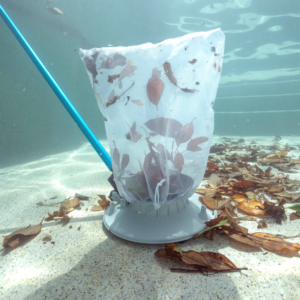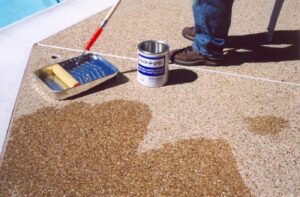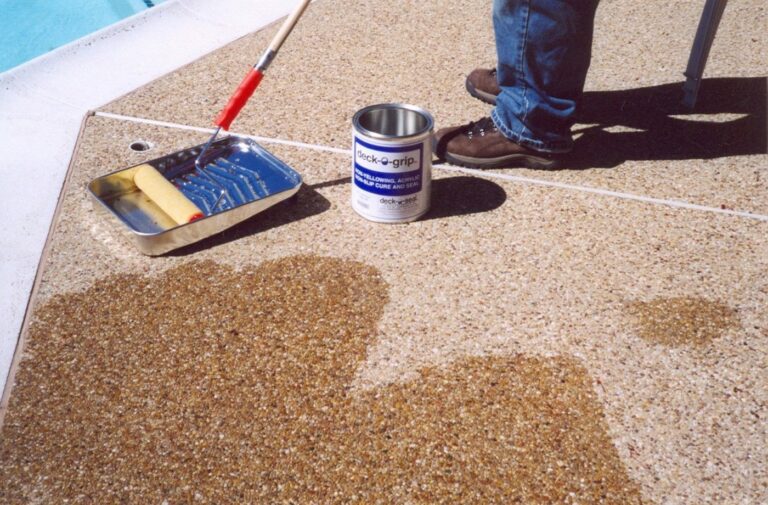Saltwater pools have gained a lot of popularity since they first started popping up in backyards in the late 70s and early 80s. Despite the interest and the length of time they’ve been gaining speed, there is still quite a lot of mystery around saltwater pools.
One aspect of saltwater pool ownership that piques a lot of interest is whether or not saltwater pool maintenance is less costly and time-consuming than chlorine pool maintenance. With that in mind, here is the lowdown on saltwater pool maintenance savings.
How Do Saltwater Pools Sanitize?
Let’s start with the basics, as the manner in which saltwater pools sanitize is still quite widely misunderstood. Contrary to popular belief, saltwater pools are mainly sanitized by chlorine. Despite not adding chlorine directly to the pool water, saltwater pool owners still swim in a chlorine-sanitized pool.
While salt has some ability to kill bacteria, it is not powerful enough to take on pool sanitization. Saltwater pools employ the use of a salt chlorine generator to convert sodium chloride (NaCl, which is also known as table salt) to chlorine gas. The electricity in the generator splits the molecules to create chlorine. The salt is converted back to NaCl and goes back through the process. Salt is simply added to the pool water and when that water runs through the generator the salt is converted to chlorine.
It is the cell inside the generator that does the conversion. Inside the cell are ruthenium or iridium coated blades. The control board portion of the cell sends a charge through the blades, which causes the reaction. The resulting chlorine gas dissolves and becomes HOCl (hypochlorous acid) or pure chlorine.
Saltwater Pools are Not Maintenance Free
Another misconception about saltwater pools is that they are maintenance free. It’s true that saltwater pool upkeep has its perks (see our next section for a complete list of those!), but there is still maintenance required. Saltwater pool owners still need to test their water two to three times per week. This means buying test strips or digital testing readers.
Saltwater pool owners need to stay on top of free chlorine, pH, alkalinity, calcium, and cyanuric acid levels. For a saltwater pool, pH should be at around 7.6, alkalinity in the 70 to 80 ppm range, and cyanuric acid levels in the 50 to 80 ppm range. Calcium levels in the range of 800 to 1200 ppm helps prevent scaling on the plates of the salt cell and along the waterline.
Saltwater pool owners also need to test salinity levels to ensure that there is enough salt in the water for proper sanitization. These checks should be done at least once a month and after each time it rains or when the pool has seen some heavy use, such as after a pool party. Salt levels should be between 2700 and 3400 ppm (parts per million) to keep the water properly sanitized. While salt is not used up by the generator process, splashing leads to lower levels in the pool and rain dilutes the salt running through the system.
What are the Perks of Saltwater Pool Maintenance?
When people discover that saltwater pool systems still sanitize with chlorine, they sometimes wonder about the motivation to switch to a saltwater system. Here are some of the primary maintenance benefits of having a saltwater system:
- Pool owners don’t have to handle harsh chemicals
- Unlike some pool chemicals, salt is not in short supply
- Salt is less expensive to purchase than other pool sanitizers
- Saltwater pools typically don’t require as many different chemicals as other pools
- Chlorine levels remain more constant than in a traditional chlorine-sanitized pool
- The generator can be adjusted to normalize the free chlorine levels in the pool
- Most salt systems include a control panel to quickly adjust for the amount of chlorine needed.
- Reduced chloramine (the used-up chlorine that causes the distinctive odor and eye/skin irritation) levels mean less need for extra chemicals to clear them
Overall Cost and Time Savings of Saltwater Pool Maintenance
So how much does it cost to maintain a saltwater pool? According to HomeAdvisor, the average annual cost to purchase all of the pure, pool grade salt and chemicals needed for the year will be about $70 to $100. And for a traditional chlorine pool, annual chemical costs are usually between $100 and $400.
As far as time goes, as mentioned, saltwater pools still need water testing done on a regular basis. This also means that test strips or testing equipment still needs to be purchased, just like with a traditional chlorine pool.
Making adjustments to the chlorine levels can typically be done quite simply by changing the settings on the control panel. Some traditional chlorine may still be needed (in the form of tablets or liquid) to shock the pool from time to time, unless the saltwater generator has a boost function for adding a higher dose of chlorine.
Saltwater pool owners also need to factor in the cost of replacing the salt cell every three to seven years. The cost to replace them is usually between $700 and $1100, depending on the system.
In addition, salt cell plates are prone to calcium buildup. To maintain proper function, the plates must be cleaned. This process should be done at least twice per year. Those with hard water may need to descale the plates every two months.
Cleaning a Salt Cell
- Turn off the system at the breaker
- Unplug the cell
- Unscrew the nuts on the cell and remove the cell
- Release pressure from the filter
- Place the cell into the cell stand (ensure the cable is at the top)
- You may want to place the cell into a bucket
- Mix a water to muriatic acid solution (carefully follow the manufacturer’s recommendations for ratios)
- Be sure to add the acid to the water rather than the other way around to avoid splashing of the acid
- Pour the solution into the cell to completely cover the blades
- After about 10 minutes the bubbling should stop and the solution can be poured out
- Rinse with clean water and inspect to be sure the buildup has been eliminated
- Repeat if the plates are still not clean
- Once clean, reattach the cell and turn the pump on
Extend Salt Cell Life
Keeping a salt cell in top condition is paramount for saltwater pool owners. Including GLB® Cell Extend in a regular pool care routine provides a multitude of benefits. First and foremost, this three-in-one product (enzymes, clarifiers, and sequestering agents) prevents scaling and build-up on the salt cell. In addition, it breaks down organic matter in the water to help maintain clarity and it prevents oxidation of any metals in the pool by suspending them in the water.
Incorporating GLB Cell Extend into regular pool care is easy. Saltwater pool owners simply add 1 quart of the product for every 20,000 gallons of water at the start of the season, and then maintain it by adding 8 fluid ounces per 20,000 gallons of water, monthly.
The Salt You Use Makes a Difference
It is important to note that not all pool salt is created equal. Just because salt is designated as pool grade does not mean that it will necessarily work optimally in a saltwater pool. Many brands of pool salt require a lot of brushing to get the salt to properly dissolve in the water. AQUASALT® is the preferred brand of professionals and informed pool owners due to the fact that the product almost completely dissolves before it reaches the bottom of the pool.
Want to learn more about saltwater pool maintenance and about the manufacturers we represent? Get in touch with your pool and spa manufacturer rep at hello@alphawest.com.









